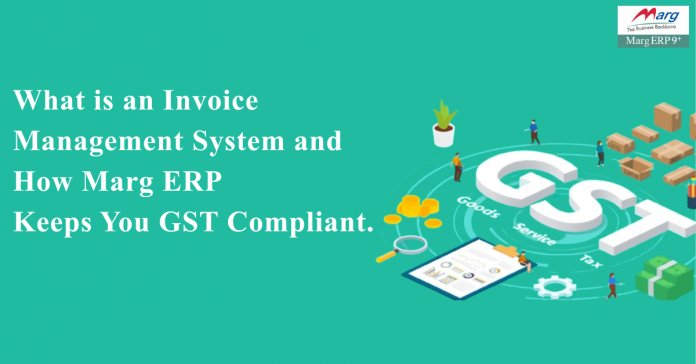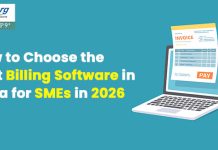GST is going through a lot of changes and evolutions in recent months from GST 2.0 announced on 3rd September 2025 (effective from 22nd September 2025) to GSTR-9 Table 8A update in IMS (Invoice Management System) announced on 17th October 2025.
GST 2.0 has reduced tax slabs majorly from 4 to 2 (5% and 18%). It also introduced ‘Nil” tax for essential items and ‘Sin Tax’ 40% for ultra-luxurious and tobacco products.
Advanced Pharma Distribution Software like Marg ERP enable a single slot tax update on Marg Users’ dashboard. Marg is one stop solution for complete accounting and inventory management with integrations and auto bank reconciliation with over 140 banks.
For the passage today, we will explore Invoice Management System and recent decision taken by the GST Council that will enhance invoicing and accounting process for all businesses. We also suggest exploring Marg ERP for a single platform for all inventory and billing requirements.
What is Invoice Management System?
Invoice Management System (IMS) is a tool within the GST portal. It helps recipient taxpayers check and control invoices that their suppliers file. Within IMS, when tax authorities file a debit/credit note or invoice under GSTR-1/GSTR-1A/IFF (Invoice Furnishing Facility), taxpayer can;
- Accept it (you agree with it)
- Reject it (you find an issue or don’t agree)
- Keep it Pending (you want to verify/you are not sure)
Why Was it Introduced?
IMS was introduced bridge the mismatches between what supplier report and what recipients claim as Input Tax Credit (ITC). This gap in the communication cause errors in claims, notices, or disputes. WIth IMS, recipients/taxpayers can verify what’s being claimed by suppliers, before it affects their tax credits.
How it Works?
- Supplier filer invoice or credit note in their GSTR-1 or IFF or IA.
- That invoice appears in your IMS Dashboard on GST Portal.
- You check it.
- If all is good, you can accept it.
- If there is an issue, you can reject it.
- If you want to verify, you can mark it as Pending.
Based on your decision (Accept/Reject/Pending), the invoice may or may not count toward your Input Tax Credit when you file your GST returns via GSTR-2B or GSTR-3B).
If you do not take any action within the allowed time, the system may treat it as “accepted by default or goes into GSTR-2B.
Key Dates Related to Invoice Management System
- IMS became available from October 2024 onward.
- Tax-payers could begin taking actions on invoices from 14 October 2024.
- Some invoices or records that are not eligible for ITC under specific GST rules (e.g. Section 16(4)) don’t appear in IMS.
- GSTR-9 Table 8A update in IMS (Invoice Management System) announced on 17th October 2025.
What is GSTR-9 Table 8A?
Table-8A of the GSTR-9 is a crucial section for taxpayers to note. It gets auto-populated with the Input Tax Credit (ITC) information for the entire financial year from the corresponding GSTR-2B returns (from GSTR-2A returns until FY 2022-23).
GST Council has announced a major update on 17th October 2025. According to the new update, Table 8A of GSTR 9 will include all the inward supplies pertaining to FY 2024-25 appearing in GSTR 2B of FY 2024-25. It will also include the invoices pertaining to FY 2024-25 appearing in GSTR 2B of next year 2025-26 between April 2025 to October 2025.
Key Updates Taxpayers Need to Know Before GST Returns for FY 2024-25
- Businesses filing annual GST returns (GSTR 9/9C) must update their system as per latest GST changes before 31st December 2025.
- Table 8A will now draw data from the new Invoice Management System (IMS), requiring taxpayers to verify details carefully.
- Table 8C computation rules have been revised, affecting how Input Tax Credit figures are reconciled.
- A new table 6A1 has been introduced to capture ITC claimed, reversed, or reclaimed across different years.
- Changes via GSTR-1A will now reflect in Tables 4 and 5 of GSTR-9.
Stay GST Compliant and Growth Ready with Marg ERP
GST regulations in India keep evolving from new return formats and invoice matching systems to due date revisions. For businesses, staying compliant can be complex and time-consuming. Marg ERP simplifies this process by keeping your accounting, billing, and tax filing always aligned with the latest GST updates.
How Marg GST Billing Software Helps Businesses Stay Future Ready.
Automatic GST Updates
Marg ERP instantly adapts to new GST rules like Table 8A of GSTR 9, notifications, and return formats issued by the government. Also, you can update GST 2.0 tax rates in your dashboard in a few clicks.
Smart Invoice Reconciliation
Automatically matches your purchase records with supplier invoices under the new Invoice Management System (IMS), helping you accept, reject, or keep invoices pending with accuracy.
Real-Time ITC Tracking
Tracks eligible Input Tax Credit (ITC) and flags mismatches or missing invoices to prevent credit loss.
Dynamic Return Calendar
Updates GSTR-1, GSTR-3B, and other return deadlines automatically when due dates are extended or modified.
Complete Audit Trail
GST Billing Software from Marg maintains timestamped records of every GST action to ensure transparency and readiness for audits.
Easy Compliance Reports
Generate accurate GST summaries and over 1000 reconciliation reports in just a few clicks. Marg Billing Software has connected banking with SBI, ICICI Bank, J&K Bank, Axis Bank, and IndusInd Bank. It also offers auto-reconciliation with over 140 banks.
With Marg ERP, businesses do not just comply, they stay confidently prepared for every GST change.
Frequently Asked Questions
What is Marg GST Software?
Marg GST Software is a GST-compliant billing & return-filing solution that helps businesses generate invoices, do accounting, and file GST returns directly within the software.
Can I use Marg as my billing software for GST-compliant invoices?
Yes. Marg ERP acts as Billing Software with GST invoicing features. You can create GST-ready invoices, track payments, and manage invoicing in compliance with GST rules.
How does Marg invoicing software support GST return filing?
Marg invoicing software, as part of its GST Software capabilities, lets you file GSTR-1, 3B, 4, 9 etc. directly from the software, and helps with reconciliation (e.g. GSTR-2A) to minimise errors.
Is Marg GST Software easy to implement and start using?
Yes, the implementation is user-friendly and cost efficient. Marg GST Billing Software can be set up quickly (takes about 5-10 minutes) to start billing and creating GST-compliant invoice.
Can Marg GST Software handle multiple features like e-invoicing and e-way bills?
Absolutely, besides invoicing and billing, Marg GST Software includes features like e-invoicing, generating e-way bills in single or bulk mode, internal audit validations, and TDS / TCS return filing




















